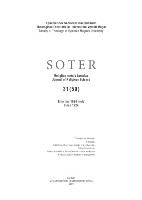Klaipėdos katalikų bažnyčių chorai tradicijos ir inovacijų aspektu
KLAIPĖDA CATHOLIC CHURCH CHOIRS IN THE CONTEXT OF THE TRADITION AND INNOVATIONS
Author(s): Regimantas GudelisSubject(s): Christian Theology and Religion
Published by: Vytauto Didžiojo Universitetas
Keywords: katalikų bažnyčios; giedojimas; liturginis ritualas; choras; mišios; vargonininkas; sakralinis koncertas; Catholic churches; choral chanting; liturgical ritual; choir; Mass; organist; concerts of sacred music
Summary/Abstract: Choral chanting in Catholic churches has been and still remains one of the most effective means of practicing liturgical rituals in educating the community about spiritual values and art culture since the oldest times. The beginning of choral art in Lithuania dates back to its christening, i.e., the end of the 14th century. There were good choirs in central churches and estates of feudal Lithuania, but after Lithuania and Poland had been annexed to Russia in 1795, this early choral culture weakened. The revival started only at the very end of the 19th century - the beginning of the 20th century, when Lithuanian national rebirth and the movement of Lithuanian choirs started. The organization of the choirs was inspired by national motivation and the cecijalists’ movement which began in Western Europe at the end of the 19th century and was supported by the document of Pope Pius X Motu proprio, which was supposed to have been significant for the epoch. Under the influence of these factors there had appeared a lot of good choirs in Lithuanian churches before World War I started, and the most important forms of liturgical chanting had consolidated. In Klaipėda, which belonged to Germany, until the middle of the 20th century, German culture and Lutheranism were dominant, but in the second half of the century the political situation and population changed - Lithuanian national culture and Catholic Church representing its identity began to dominate. In 1923 the so called Klaipėda region was annexed by Lithuania. The number of Klaipėda population, Catholics among them, was rapidly increasing. The conversion to Catholicism and Lithuanianization in Klaipėda was interrupted by German invasion on March 22, 1939. Soviet occupation made a negative impact on Catholic Church. Religious liberty was restricted, the modern Marijos Taikos Karalienės Church (Mary the Queen of Peace), the building of which was financed by Catholics, was confiscated. It was returned to Catholics at the end of the occupation period - December 24, 1988. Currently, according to the data of 2008, the population of Klaipėda is 183 823, among the residents 71,3 % are Lithuanians, 18,5 % are Roman Catholics. There are 4 Catholic churches: Marijos Taikos Karalienės (Mary the Queen of Peace), Kristus Karalius (Christ the King), Juozapas Darbininkas (St. Joseph the Labourer) and St. Kazimieras (St. Casimir’s). The biggest and the most professional choir are in Marijos Taikos Karalienės church (Mary the Queen of Peace) (45-50), in other churches the number is 30-35 people. There are children choir groups, and St. Mary’s church even has a group of Gregorian chant. Klaipėda Catholic Church choral tradition, compared with other Lithuanian churches is very young and still growing. However, its intensive conversion has innovations in itself, positive ambitions, which could be significant for both Klaipėda and other Lithuanian churches. The author of the article discerned the most perspective exampl
Journal: SOTER: religijos mokslo žurnalas
- Issue Year: 59/2009
- Issue No: 31
- Page Range: 149-167
- Page Count: 19
- Language: Lithuanian

